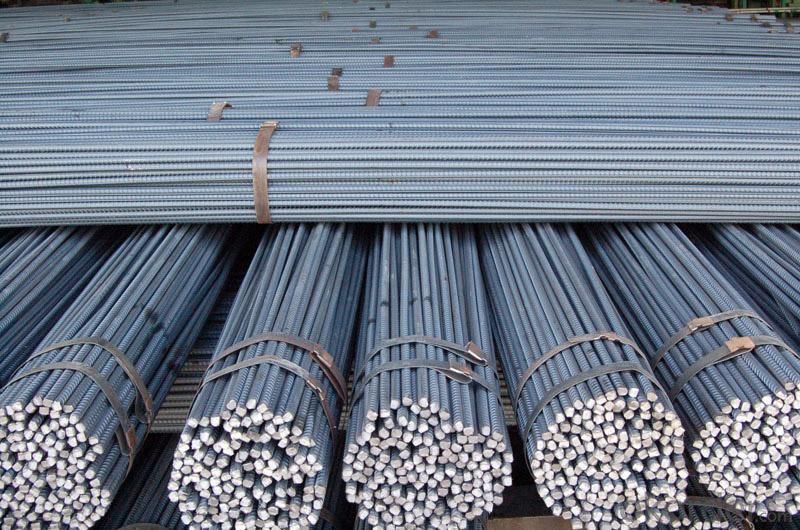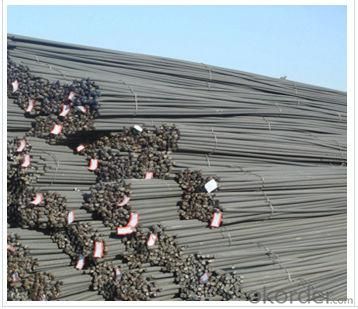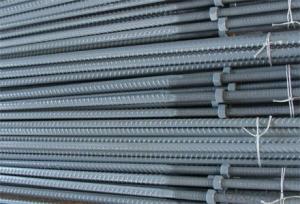GR40 deformed steel bar bar for construction
- Loading Port:
- Tianjin
- Payment Terms:
- TT OR LC
- Min Order Qty:
- 10000 m.t.
- Supply Capability:
- 100000 m.t./month
OKorder Service Pledge
OKorder Financial Service
You Might Also Like
Item specifice
OKorder is offering high quality GR40 deformed steel bar bar for construction at great prices with worldwide shipping. Our supplier is a world-class manufacturer of steel, with our products utilized the world over. OKorder annually supplies products to European, North American and Asian markets. We provide quotations within 24 hours of receiving an inquiry and guarantee competitive prices.
Product Applications:
GR40 deformed steel bar bar for construction for construction for construction are ideal for structural applications and are widely used in the construction of buildings and bridges, and the manufacturing, petrochemical, and transportation industries.
Product Advantages:



OKorder's deformed steel bar are durable, strong, and resist corrosion.
Main Product Features:
· Premium quality
· Prompt delivery & seaworthy packing (30 days after receiving deposit)
· Corrosion resistance
· Can be recycled and reused
· Mill test certification
· Professional Service
· Competitive pricing
Product Specifications:
Standard | GB | HRB400 | |
Diameter | 6mm,8mm,10mm,12mm,14mm,16mm,18mm,20mm, 22mm,25mm,28mm,32mm,36mm,40mm,50mm | ||
Length | 6M, 9M,12M or as required | ||
Place of origin | Hebei, China mainland | ||
Advantages | exact size, regular package, chemical and mechanical properties are stable. | ||
Type | Hot rolled deformed steel bar | ||
Brand name | DRAGON | ||
Chemical Composition: (Please kindly find our chemistry of our material based on HRB500 as below for your information)
Grade | Technical data of the original chemical composition (%) | ||||||
C | Mn | Si | S | P | V | ||
HRB400 | ≤0.25 | ≤1.60 | ≤0.80 | ≤0.045 | ≤0.045 | 0.04-0.12 | |
Physical capability | |||||||
Yield Strength (N/cm²) | Tensile Strength (N/cm²) | Elongation (%) | |||||
≥400 | ≥570 | ≥14 | |||||
Theoretical weight and section area of each diameter as below for your information:
Diameter(mm) | Section area (mm²) | Mass(kg/m) | Weight of 12m bar(kg) |
6 | 28.27 | 0.222 | 2.664 |
8 | 50.27 | 0.395 | 4.74 |
10 | 78.54 | 0.617 | 7.404 |
12 | 113.1 | 0.888 | 10.656 |
14 | 153.9 | 1.21 | 14.52 |
16 | 201.1 | 1.58 | 18.96 |
18 | 254.5 | 2.00 | 24 |
20 | 314.2 | 2.47 | 29.64 |
22 | 380.1 | 2.98 | 35.76 |
25 | 490.9 | 3.85 | 46.2 |
28 | 615.8 | 4.83 | 57.96 |
32 | 804.2 | 6.31 | 75.72 |
36 | 1018 | 7.99 | 98.88 |
40 | 1257 | 9.87 | 118.44 |
50 | 1964 | 15.42 | 185.04 |
Deformed bar is widely used in buildings, bridges, roads and other engineering construction. Big to highways, railways, bridges, culverts, tunnels, public facilities such as flood control, dam, small to housing construction, beam, column, wall and the foundation of the plate, deformed bar is an integral structure material. With the development of world economy and the vigorous development of infrastructure construction, real estate, the demand for deformed bar will be larger and larger..
Packaging & Delivery of HR Deformed Steel Rebars of Good Quality: Packaging Detail: products are packed in bundle and then shipped by container or bulk vessel, deformed bar is usually naked strapping delivery, when storing, please pay attention to moisture proof. The performance of rust will produce adverse effect. Each bundle weight: 2-3MT, or as required Payment terms: TT payment in advance or Irrevocable LC at sight. Trade terms :FOB, CFR, CIF Delivery Detail: within 45 days after received advanced payment or LC. FAQ: Q1: What makes stainless steel stainless? A1: Stainless steel must contain at least 10.5 % chromium. It is this element that reacts with the oxygen in the air to form a complex chrome-oxide surface layer that is invisible but strong enough to prevent further oxygen from "staining" (rusting) the surface. Higher levels of chromium and the addition of other alloying elements such as nickel and molybdenum enhance this surface layer and improve the corrosion resistance of the stainless material. Q2: Can stainless steel rust? A2: Stainless does not "rust" as you think of regular steel rusting with a red oxide on the surface that flakes off. If you see red rust it is probably due to some iron particles that have contaminated the surface of the stainless steel and it is these iron particles that are rusting. Look at the source of the rusting and see if you can remove it from the surface. |
- Q:How are steel rebars classified based on their diameter?
- Steel rebars are classified based on their diameter using a standardized system. The diameter of rebars is measured in millimeters and is denoted by a number. The most commonly used classification system for rebars is the "nominal diameter" system, where rebars are categorized into different sizes based on their diameter. The nominal diameter is expressed as a whole number, for example, 6, 8, 10, 12, etc. In this system, the nominal diameter represents the approximate diameter of the rebar in millimeters. For instance, a rebar with a nominal diameter of 8 has an approximate diameter of 8 millimeters. The diameter of rebars can range from as small as 6 millimeters to as large as 50 millimeters or more. It is important to note that the actual diameter of a rebar may vary slightly from its nominal diameter due to manufacturing tolerances. However, these variations are generally within an acceptable range. The classification of steel rebars based on their diameter is crucial in construction and engineering as it helps in determining the appropriate size and strength of rebars required for a specific application. Different diameters of rebars have different load-bearing capacities and are used accordingly in various structural elements such as beams, columns, slabs, and foundations. In summary, steel rebars are classified based on their diameter using a nominal diameter system, where the approximate diameter of the rebar is expressed as a whole number in millimeters. This classification aids in selecting the right size and strength of rebars for different construction purposes.
- Q:How do steel rebars affect the overall strength of concrete structures?
- The overall strength and durability of concrete structures are significantly improved by the presence of steel rebars. These rebars are commonly used to reinforce concrete and enhance its ability to withstand stretching or pulling forces, known as tensile strength. Concrete itself is strong when compressed but weak when subjected to tension. When external forces, like bending or stretching, are applied to concrete, it tends to crack and fail. This is where steel rebars come into play. By adding rebars to the concrete, the structure's tensile strength is greatly enhanced. Rebars act as a robust framework within the concrete, providing resistance against tensile forces. When the concrete is under tension, the rebars bear the load and distribute it evenly, preventing the formation of cracks and improving the overall strength of the structure. This reinforcement also limits the spread of cracks, ensuring the structure remains intact and stable even under heavy loads or adverse conditions. Additionally, steel rebars enhance the structural integrity of concrete structures by increasing their resistance to bending, shearing, and torsional forces. They make the concrete stiffer and more resistant to deformation, thus improving its capacity to carry loads. Apart from strengthening the structure, steel rebars also play a vital role in preventing corrosion. They are made of materials that resist corrosion, such as stainless steel or galvanized steel, protecting the concrete from moisture and other corrosive elements. This ensures the longevity and durability of the concrete structure. To summarize, steel rebars greatly enhance the overall strength and durability of concrete structures by improving their tensile strength, resistance to bending and shearing forces, and preventing corrosion. They provide the necessary reinforcement to enable concrete to withstand external forces, ensuring the safety and longevity of the structure.
- Q:How do steel rebars contribute to the overall sustainability of concrete structures?
- Steel rebars contribute to the overall sustainability of concrete structures in several ways. Firstly, steel rebars enhance the durability and lifespan of concrete structures. By reinforcing the concrete, rebars provide added strength and prevent cracking or structural failures, thereby extending the life of the structure. This reduces the need for frequent repairs or replacements, saving resources and minimizing the environmental impact of construction activities. Moreover, steel rebars are 100% recyclable. At the end of a structure's life cycle, the rebars can be easily removed and recycled, reducing the demand for new raw materials and minimizing waste. This not only conserves natural resources but also reduces greenhouse gas emissions associated with the extraction and production of virgin steel. Additionally, incorporating steel rebars into concrete structures allows for the use of thinner concrete sections. By using less concrete, there is a reduced demand for cement, which is a major contributor to carbon dioxide emissions during its production. Therefore, the use of steel rebars helps to lower the overall carbon footprint of concrete structures. Furthermore, steel rebars can be designed to resist corrosion, which is a common issue in concrete structures exposed to harsh environments or in coastal areas. By providing protection against corrosion, the rebars increase the service life of the structure, reducing the need for maintenance and repairs. This not only saves costs but also reduces the environmental impact associated with maintenance activities. Overall, steel rebars play a crucial role in enhancing the sustainability of concrete structures by improving their durability, enabling recycling, reducing material consumption, and minimizing maintenance requirements. By incorporating steel rebars into concrete construction, we can create long-lasting, environmentally-friendly structures that contribute to a more sustainable built environment.
- Q:How do steel rebars affect the overall crack resistance of concrete structures?
- Steel rebars play a crucial role in enhancing the crack resistance of concrete structures. When embedded within the concrete, rebars provide reinforcement and increase the tensile strength of the structure. Concrete is inherently strong in compression but weak in tension, and steel rebars help overcome this weakness by absorbing the tensile forces that may cause cracks in the concrete. The presence of rebars in concrete structures allows for the redistribution of stress, preventing cracks from propagating and spreading. As the concrete undergoes shrinkage or experiences external loads, the rebars act as a reinforcement grid and help to resist the formation and expansion of cracks. By absorbing and distributing the tensile stresses, rebars ensure that the concrete remains intact and can withstand higher loads without significant cracking. Moreover, steel rebars also contribute to the overall durability of concrete structures. When corrosion of the rebars occurs due to exposure to moisture or other environmental factors, it can lead to an increase in volume, causing internal pressure and potential cracking of the concrete. However, the use of corrosion-resistant rebars, such as epoxy-coated or stainless steel rebars, can significantly mitigate this risk and improve the crack resistance of the structure. In summary, steel rebars enhance the crack resistance of concrete structures by providing reinforcement, increasing tensile strength, redistributing stress, and preventing crack propagation. Their presence ensures that the structure can withstand various types of loads and environmental conditions, improving both the strength and durability of the concrete.
- Q:Do steel rebars have any specific markings or codes?
- Yes, steel rebars typically have specific markings or codes to indicate their size, type, and grade. These markings are essential for identifying and ensuring the correct usage of rebars in construction projects.
- Q:What is the process of installing steel rebars in slabs and beams?
- The process of installing steel rebars in slabs and beams involves several steps. Firstly, the design and layout of the rebars are determined based on the structural requirements. The rebars are then cut, bent, and shaped according to the specifications. Next, the concrete forms for the slabs and beams are prepared, ensuring they are clean and properly aligned. Once the forms are ready, the rebars are placed inside the forms in the desired positions, maintaining the required spacing and clearances as per the design. Proper support is provided to hold the rebars in place and prevent displacement during the concrete pouring process. After the rebars are correctly positioned, concrete is poured into the forms, covering the rebars entirely. During pouring, care is taken to ensure that the concrete adequately surrounds and encases the rebars, providing the necessary structural integrity. Finally, the concrete is allowed to cure and harden, creating a strong bond with the rebars. Once the concrete has fully cured, the forms are removed, and any excess concrete or debris is cleaned off the surface. Overall, the process of installing steel rebars in slabs and beams involves careful planning, precise positioning, and proper concrete placement to create a reinforced structure that can withstand the intended loads and stresses.
- Q:Can steel rebars be used in structures with high resistance to moisture?
- Structures that require high resistance to moisture can incorporate steel rebars. Nonetheless, it is crucial to acknowledge that steel is prone to corrosion when exposed to moisture for extended periods. In order to mitigate this risk, preventive measures such as implementing adequate concrete coverage and waterproofing techniques are necessary. Furthermore, utilizing steel rebars with corrosion-resistant coatings or alloys, such as epoxy-coated or stainless steel rebars, can significantly augment moisture resistance. The longevity and durability of structures in high-moisture environments heavily rely on proper design, construction, and maintenance practices.
- Q:How are steel rebars identified based on their grades?
- Steel rebars are identified based on their grades through markings or labels on the surface of the rebars. These markings typically indicate the grade of the steel rebars, which is determined by the strength and composition of the steel.
- Q:What is the average lifespan of a reinforced concrete structure with steel rebars?
- The average lifespan of a reinforced concrete structure with steel rebars can vary depending on various factors such as design, construction quality, environmental exposure, and maintenance. However, with proper design, construction practices, and regular maintenance, reinforced concrete structures with steel rebars can typically last for several decades or even over a century.
- Q:How is thread steel made?
- Rebar is a ribbed steel bar, also known as ribbed steel, usually with 2 longitudinal ribs and transverse ribs uniformly distributed along the length. The transverse rib shape is helical, herringbone, crescent 3. Expressed in millimeters of nominal diameter. Nominal diameter of round steel bars of equal diameter equal to the cross section of ribbed bars. The nominal diameter of the steel bar is 8-50 mm, and the recommended diameters are 8, 12, 16, 20, 25, 32 and 40 mm. Ribbed steel bars are mainly subjected to tensile stress in concrete. Because of the function of rib and the greater bonding ability of concrete, ribbed steel bar can bear the effect of external force better. Ribbed steel bars are widely used in a variety of building structures, especially large, heavy, light, thin-walled and high-rise structures.
1. Manufacturer Overview |
|
|---|---|
| Location | |
| Year Established | |
| Annual Output Value | |
| Main Markets | |
| Company Certifications | |
2. Manufacturer Certificates |
|
|---|---|
| a) Certification Name | |
| Range | |
| Reference | |
| Validity Period | |
3. Manufacturer Capability |
|
|---|---|
| a)Trade Capacity | |
| Nearest Port | |
| Export Percentage | |
| No.of Employees in Trade Department | |
| Language Spoken: | |
| b)Factory Information | |
| Factory Size: | |
| No. of Production Lines | |
| Contract Manufacturing | |
| Product Price Range | |
Send your message to us
GR40 deformed steel bar bar for construction
- Loading Port:
- Tianjin
- Payment Terms:
- TT OR LC
- Min Order Qty:
- 10000 m.t.
- Supply Capability:
- 100000 m.t./month
OKorder Service Pledge
OKorder Financial Service
Similar products
New products
Hot products
Related keywords





























